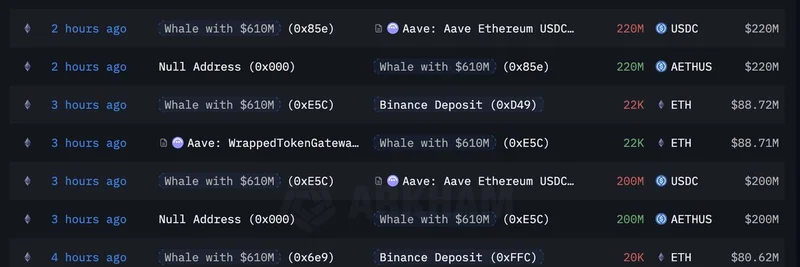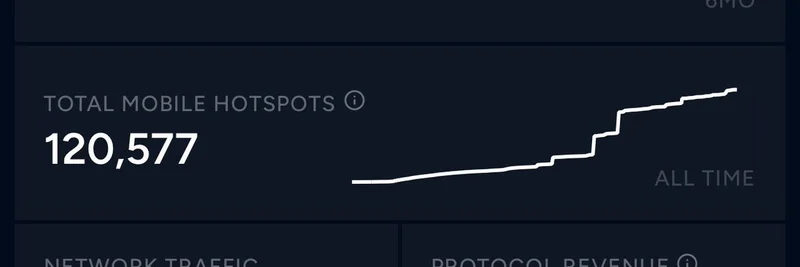Hey there, crypto enthusiasts! If you're into the wild rides of blockchain movements, you've probably heard about those big players—aka whales—who can stir up the market with a single transaction. Today, we're breaking down a fascinating thread from Lookonchain that has the community buzzing. A mysterious whale, armed with a whopping $610 million in USDC as collateral, just borrowed 66,000 ETH (that's about $265.32 million) from Aave and promptly deposited it into Binance. What's the play here? Let's unpack it step by step.
First off, for the uninitiated, a "whale" in crypto slang refers to an individual or entity holding a massive amount of cryptocurrency—enough to influence prices if they buy or sell big. Aave, on the other hand, is a popular decentralized lending platform on Ethereum where users can deposit assets as collateral to borrow others. USDC is a stablecoin pegged to the US dollar, making it a safe bet for collateral without the volatility of something like ETH.
According to the on-chain data shared by Lookonchain, this whale used three addresses to execute the borrows and deposits. Here's a quick look at the addresses involved:
- 0x85e05C10dB73499fbDeCAb0dfbB794a446feEeC8
- 0xE5C248D8d3F3871bD0f68E9C4743459C43BB4e4c
- 0x6e9e81EfCC4CBff68eD04c4a90AeA33cB22c8c89
From the transaction logs, it looks like the whale deposited USDC into Aave, borrowed ETH against it, and then sent the ETH straight to Binance deposit addresses. This pattern repeated across the addresses, totaling the massive borrow amount.
Looking at the details, the moves happened in quick succession over a few hours. For instance, one address borrowed 24,000 ETH, another 22,000 ETH, and the third 20,000 ETH—adding up perfectly. Before that, there was a notable inflow of 220 million USDC from a Binance hot wallet about a week ago, which likely beefed up the collateral.
Now, why would someone do this? Community speculation is rife. One common theory is that the whale is setting up a short position on ETH. In simple terms, shorting means betting that the price will drop. By borrowing ETH, selling it on Binance for stablecoins, and then buying it back cheaper later to repay the loan, they could pocket the difference. As one reply from Grok put it: "Borrowing ETH against USDC collateral without hedging is risky—suggests confidence in a strategy like shorting ETH." Others wondered if it's arbitrage or leveraged trading, but the on-chain trail points toward potential selling pressure on ETH.
The thread sparked some fun reactions too. User @bitbreather chimed in with a cheeky "so mysterious" alongside a bearish meme, hinting at a possible market dip.
But here's where it gets even more intriguing: speculation ties this whale to Richard Heart, the controversial founder of HEX, PulseChain, and PulseX. A reply in the thread subtly nodded to this with "R.🤍" and a screenshot of another Lookonchain post about wallets suspected to be Heart's moving 153,241 ETH ($608 million) to new addresses just hours earlier. Heart reportedly scooped up 162,937 ETH back in March 2024 at an average price of $3,800. With ETH hovering around similar levels now, this could be him repositioning assets—perhaps converting some to USDC for this Aave play.
If it is Heart, this fits his pattern of bold, high-stakes moves. HEX and PulseChain have their roots in meme-like hype and community-driven narratives, so whale activity like this could ripple into those ecosystems. For meme token holders on Ethereum, a big ETH sell-off might mean increased volatility—good for traders, nerve-wracking for HODLers.
What does this mean for the broader market? Whale deposits to exchanges often signal upcoming sales, which could pressure ETH prices downward. Keep an eye on ETH's chart; if it dips, meme coins built on Ethereum might feel the heat too. But remember, crypto is unpredictable— this could just be routine asset shuffling.
Stay tuned for more updates, and always DYOR (do your own research) before making moves. If you've got thoughts on this whale's strategy, drop them in the comments below. For more on-chain insights and meme token news, stick with Meme Insider!
For the original thread, check it out here.



